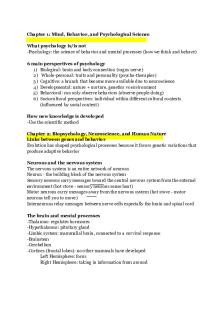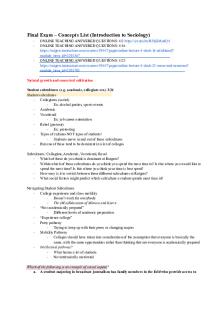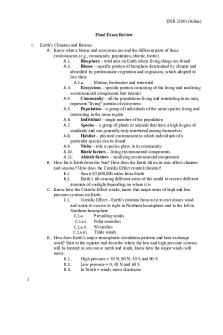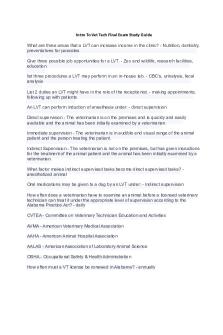Intro to Marketing Final Exam Study Guide PDF

| Title | Intro to Marketing Final Exam Study Guide |
|---|---|
| Course | Introduction to Marketing |
| Institution | Northern Alberta Institute of Technology |
| Pages | 16 |
| File Size | 376.7 KB |
| File Type | |
| Total Downloads | 44 |
| Total Views | 165 |
Summary
Intro to Marketing Final Exam Study Guide...
Description
Final Exam Review
Chapter 12 – Marketing Communications Integrated Marketing Communications (IMC) – concept of designing a marketing communications program that coordinates all promotional activities to provide a consistent message to a target audience Example: If your product is luxurious, then the whole time you should be talking how luxurious it is. You should be presenting how fancy it is the whole time during the presentations (Louis Vuitton as an example) *** Marketing Communication Tools: Advertising, Public Relations, Sales Promotion, Direct Response, Event Marketing, and Sponsorship and Personal Selling. ADVERTISING – a paid form of media used to communicate to consumers; includes broadcast, print, out1-of home, and digital media - INTERNET, TELEVISION, NEWSPAPER, MAGAZINES, RADIO, OUTDOOR/TRANSIT o Strengths: reaching large numbers of people both online and offline Many affordable online options exist for marketers with small budgets. o Weaknesses: High cost of offline approaches Difficult to evaluate offline approaches PUBLIC RELATIONS – seeks to influence the opinions and attitudes of target groups through the use of unpaid media exposure. o Strengths: Highly credible messages when spread by the media Inexpensive by using media o Weakness: Unable to control media messaging SALES PROMOTION – provides a short-term incentive to generate interest in a product or cause and encourages purchase or support. (ex, in Starbucks they only have Holiday drinks on winter season!) o Strengths:
1
Effective at increasing short-term sales
Results are measurable o Weakness: Fraudulent involvement can occur Can be easily duplicate by competitors DIRECT RESPOSE – designed to communicate with consumers one-on-one and to elicit a direct action either online or offline. o Strengths: Messages can be targeted offline and online Facilitate customer relationship o Weakness: High cost offline and online approaches Negative customers reaction EVENT MARKETING – creation or involvement of a brand in an experience or occasion that heightens its awareness, creates positive associations, and generates a desired response. SPONSORSHIP – involves a company paying a fee in exchange for inclusion in an even, involvement in its advertising opportunities, or exposure within the event itself. o Strengths: Small Branded events can be used to create a buzz and spread viral messages Major event sponsorships can reach large audiences and create positive associations o Weakness: Large event-sponsorships can be limited to awareness-building messages Sponsorships can be costly and difficult to evaluate PERSONAL SELLING – involves the two-way flow of communication between a buyer and seller, often face-to-face or facilitated through communication devices, to influence an individual or group purchase-decision. o Strengths: Personal Interactions can build lasting relationships with consumers o Weakness: Can become expensive when large salesforces are involved
2
WORD OF MOUTH – communication is based on transparent and honest communication. - Works by listening to consumers, identifying influential individuals, providing important information, and making it easier for them to spread the word. PRODUCT PLACEMENT – the inclusion of a product in a movie or TC program in return for payment.
Chapter 13 - Mobile Marketing and Social Media Marketing Mobile is changing the marketing because today, consumers connect with each other an to brands using social media, whether this is with Facebook to locate an offer, Twitter to lodge a complaint, or various other social networks to stay connected with friends. Mobile marketing approaches to reach consumers on mobile devices, whether this be on a smartphone, tablet, e-readers, or other handheld device. Mobile Marketing- a set of practices that enables organizations to communicate and engage with their audiences in an interactive and relevant manner through any mobile device or work. Social Media Marketing- when brands reach out to consume online through social networks where people connect with friends and contacts to share comments, articles, opinions, videos, and images as a form of self -expression.
Chapter 7 – Products and Brands (Reading: Entire chapter) Key Concepts Four I’s of services Total product concept Importance of packaging & labelling Importance of branding
3
Key Definitions Product Service Product line Product mix Product width Product depth Brand Brand equity Individual brand Family brand Brand extension
Sub-brand Brand loyalty Brand personality The essence of marketing lies in managing and developing products and brands that meets the need of the target markets. In marketing PRODUCT is a good, service, or an idea, consisting of a bundle of tangible and intangible attributes. 1. Tangible attributes physical characteristics; color, sweetness 2. Intangible attributes of can’t be “touched” Offline environment: examples products are breakfast cereal, or emergency services provided by a hospital Online environment: examples are search engines, Google, micro-blogging such as Twitter Product is divided into three main Category 3. Non-durable good is an item that does not last and is consumed only once, for a limited number of time food products, fuel, etc. 4. Durable good is a product that lasts for an extended period of time appliances, automobiles 5. SERVICE is an INTANGIBLE ACTIVITY, BENFIT, SATISFICATION banking, conducting an online analytics search, going to a movie, taking a course Primary service – main “product” Supplementary service – often allow products to differentiate their offerings from the competition while adding value to consumers 6. Product updates, free delivery, payment terms, complimentary consultations, order-taking, and sales assistance Virtual – exist only online and have no physical person-to-person interaction or tangible component The Uniqueness of Services (FOUR I’s of SERVICES) Intangibility: cannot be held, touched, or seen before a purchase. Drawbacks: Since buyers can’t experience the product, the marketers use techniques that are frequently used; online video or testimonials or demonstration that show the quality of the service In Cineplex, they don’t sell a product, but they sell experience. To promote, they have to use their promotional videos of how good AVX theatre to sell experience. Inconsistency: Quality can vary with each person’s capabilities, experience, motivation, and even personality.
4
Drawbacks: Different promotions, place, price, product experiences you will get. So, Companies try to overcome inconsistency by training employees on how to deliver a consistent quality experience. Starbucks at Nait always gives an impression of happiness, and professionalism, but when you go to a different location such as U of A Starbucks they give you a different vibe such as not welcoming. Inseparability: cannot separate the deliverer of the service from the service itself. If at Cineplex, Justine Encarnacion has poor skills giving away the ticket, this will reflects poorly at Cineplex, which may be in fact excellent. Inventory: problems exist because services cannot necessarily be stored and accessed when in demand. 7. Perishability: arises when products cannot be stored for long periods of time for use at a later date. 8. Idle Production Capacity: when the supply of a services exceeds is demand o Drawbacks: It is expensive and arises when a service is available when there is little demand. To deal with this, the service industry often uses part-time employees who are paid an hourly wage and are schedules to work shifts. Total Product Concept Core Product, Actual Product, Augmented Product Core product – what product does for the customer- the benefits derived from using the product Actual product- the physical good or service, including the branding, design, and features that consumer receives Augmented product- Additional features that accompany the product, such as warranty, a service contract, delivery options, installation, or a website. Packaging and Labelling 9. Provides benefits such as protection or facilitating product usage. 10. Serve platforms from which to communicate brand imagery, product information and offers
Product Line- group of similar products with the same product and brand name Example: Gatorade Perform line, Gatorade recover, Gatorade Prime Product Mix- refers to the array of product lines marketed by a company. Product Width- the number of different categories offered by a company Product Depth- the variety of product lines and products sold within a company’s product categories, groups, and lines
5
Brand- is a name or phrase uniquely given by a company to identify its product(s) and to distinguish the product(s) from the competition 11. Developing and nurturing a brand is an important factor in the marketing of a product. This involves creating a new brand name or selecting a name that already exists in a company’s arsenal. Brand Equity- formally described as the value of a brand that results from favourable exposure, interactions, associations, and experiences that consumers have with a brand over time. (example, Starbucks- they have a brand equity to me because I don’t fairly go to other coffee shops) Brands are Classified as Individual, Family, Brand Extension, or Sub- Brand Individual Brand- when a company uses a brand name solely for a specific product category Family Brand- when a company uses a brand name to cover a number of different product categories (Crest is only for toothpaste, now it is used for more than one- mouthwash, dental-floss, teeth whitening Brand Extension- when new goods or service goods are introduced under an existing flagship brand name Sub-brand- uses the family name as well as its own brand name and identify so that It can take on the strengths of the parent rand but also differentiate itself.
Brand Loyalty- refers to the favourable attitudes that a consumer has over time toward a brand that results in varying levels of purchase insistence and committed to the brand. (For Example, Freddie is loyal to CoCos because of the environment they have for the store, he doesn’t go to Dream Tea much often for the reason being of his brand attachment to the Company of CoCos) Brand personality- own set of human characteristics associated with the brand (Freddie likes the aesthetics satisfaction he gets from Starbucks, the luxurious feelings) Chapter 8 – New Product Development (Reading: Entire chapter) Key Concepts Why the Product Life Cycle (PLC) is important? Stages of the PLC & marketing implications at each stage Alternate PLC shapes Various product life cycle strategies 3 degrees of innovations (Minor, Continuous, Radical) (Fig 8-5) 6
Key Definitions Product life cycle (PLC) Line extension New product development strategy Idea generation Screening & evaluation Concept tests Business analysis
The adoption curve (Fig 8-6) Reasons for new-product failures New product development process
Development Test marketing Commercialization
Product Life Cycle- describes the stages that a new product goes through, starting with its initial introduction into the market place and moving through the stages of growth, maturity, and decline. 12. The concept of the PLC s use by many marketers to help manage a product from its initial launch through its eventual decline Stages of PLC INTRODUCION Stage- When a product is first introduced to its intended target market. 13. Slow sales growth 14. High research and development costs to bring the product to the market 15. High levels of marketing spending needed to launch the new product GROWTH stage- increase in competition and a rapid rise in sales and profits 16. Focused on differentiating products from a competitive offering 17. Pricing levels are generally lowered to become more competitive and distribution increase 18. Promotion becomes more product-specific MATURITY stage- characterized by a slowdown of growth in both the sales and profit areas. 19. Longest stage and marketers focusing efforts to ensure the product des not go into decline 20. Uses promotional tactics such as consumer promotions to encourage consumers to purchase the product 21. Product innovation can also become a priority as marketers try to reposition products (more competitive and relevant to consumers’ need DECLINE stage- occurs when sales and profits steadily decline over time 22. Products enters this stage when products become obsolete due to technological innovation or changes in consumer needs Shape of the Product Life Cycle (ALTERNATIVE Product Life Cycle) A. High-learning products B. Low- learning products C. Fashion products D. Fad Products High-learning products- where there is an extended introductory period due to the significant efforts required to educate customers on the usage and benefits of the product Low- learning products- short introductory stage in the product life cycle. Fashion products- short and cyclical, going from introduction to decline within two or three years, only to resurface a few years later
7
Fad products- short product life cycle that experience immediate rapid growth, followed by an equally rapid decline
Product Life Cycle Strategies 1. Targeting current users with extended usage strategies 2. Targeting new consumers through new marketing approaches 3. Revitalizing a product with product improvements and line extensions 4. Repositioning a product 5. Introducing a new product 6. Finding new uses for a product (read textbook for brief info) Line extensions-term used when a new item is added to an already existing product line (Tim Hortons adding premium espresso lattes, mocha lattes etc) Degree of Product Innovation MINOR innovations- minor product modifications that requires no adjustment on behalf of the consumer.
8
CONTINUOUS innovations- new product that include more than just a minor product improvement but do not require radical changes in consumer behavior RADICAL innovations- new products that involve the introduction of a product that is entirely new and innovative to the market ADAPTION CURVE- takes a point of view that some consumers are readier than others to buy product innovations Innovators – higher educated Early adopters- slightly above average education Early Minority- many informal social contacts Late Majority- below average social status Laggards- neighbors and friends are information sources
Reasons for New-Product Failures 1. Insignificant point of difference a. Distinctive and meaningful point of difference is essential for a new product to compete 2. Incomplete new-concept definition a. It needs a well-defined, consumer-based reason for being 3. Insufficient market attractiveness a. Strong consumer appeal in a category with both growth and profit potential 4. Inadequate marketing support a. Often launch products with little marketing support 5. Insensitivity to critical customer needs a. Ignoring critical consumer insight can kill a product 6. Bad timing a. a product can suffer negative consequences if it is introduced too soon, too late 7. Limited access to buyers a. Often difficult to obtain the necessary distribution to reach a target market
9
The New Product Development Process 1. New Product development strategy 2. Idea generation 3. Screening and evaluation 4. Business analysis 5. Development 6. Test marketing 7. Commercialization New Product Development Strategy- setting new product strategic direction for the company as a whole Idea Generation- Focuses on brainstorming sessions to prompt new ideas Screening and Evaluation- reduces the list of brainstorming ideas down to a list of promising concepts 23. Concept test: External evaluations of a new product idea, rather than the actual product itself Business Analysis- Financial Projections on the impact of bringing the new market and selling it in the future Development- new product idea turned into a prototype for further consumers research and manufacturing tests Test Marketing- Offering new product for sale on a limited basis in a defined geographic area to assess its success Commercialization- when the new product is brought to market with full-scale production, sales, and marketing support Chapter 9 – Pricing (Reading: Pages 220-232, 238-241) Key Concepts Importance of choosing the right price Price as an indicator of value Demand-Oriented Pricing Approaches: Skimming Pricing Penetration Pricing Prestige Pricing Price Lining Odd-Even Pricing Target Pricing Bundle Pricing
10
Key Definitions Price Value Profit equation
Yield Management Pricing Cost-Oriented Pricing Approaches: Standard Markup Pricing Cost-Plus Pricing Profit-Oriented Pricing Approaches: Target Profit Pricing Target Return-on-Sales Pricing Target Return-on-Investment Pricing Competition Oriented Pricing Approaches: Customary Pricing Above, At, or Below Market Pricing Loss-Leader Pricing Various pricing objectives Various pricing constraints 4 common illegal pricing practices 4 common deceptive pricing practices Price- is the money or other considerations, including other goods and services, exchanged for the owenership or use of product. Value- The ratio of perceived benefits to price Price as an Indicator of Value Value = Perceived benefits / Price For a given price, as perceived benefit increase, value increases Demand- Orientated Approaches (Skimming, Penetration, Prestige, odd-even, Target, Bundle, Yield Management) SKIMMING pricing- setting highest initial price that those customers really desiring the product are willing to pay PENETRATION pricing- low initial price on a new product to appeal immediately to the mass market PRESTIGE pricing- setting a high price so that the quality or status-conscious consumers are attracted to the product and buy it PRICE LINING- selling not just a single product but a line of products may price them at a number of different specific pricing points ODD-EVEN pricing- setting few dollars or cents under an even number TARGET pricing- adjusting the composition and features of a product to achieve the target price to consumers BUNDLE pricing- marketing of two or more products in a single “package”. Pricing often provides a lower total cost to buyers and lower marketing costs to sellers
11
YIELD MANAGEMENT pricing- the charging of different prices to maximize revenue for a set amount of capacity at any given time. Cost- Oriented Approaches (Standard Markup, Cost Plus) STANDUP MARKUP pricing- firms sell their products at a price that exceeds their costs of producing or sourcing the items and the cost of marketing them. 24. The difference between selling price and cost, dividing by cost COST-PLUS pricing- involves summing the total unit cost of providing a product or service and adding a specific amount to the cost to arrive at a price Profit- Oriented Approaches (Target Profit, Target Return-on-Sales, Target Return-on-Investment) TARGET PROFIT pricing- firms sets an annual target of a specific dollar amount of profit TARGET RETURN-ON-SALES pricing- set prices that will give them a profit that is a specified percentage TARGET RETURN-ON-INVESTMENT pricing- set prices to achieve return of investments (ROI)
Competition- Orientated Approaches (Customary, Above-, at, or Below-Market, Loss-Leader) CUSTOMARY pricing- for some products where tradition, a standardized channel of distribution, or other competitive factors dictate the price ABOVE-,at-, or BELOW-MARKET pricing- the “market price” is what customers are generally willing to pay; used as a benchmark to then competitively position a product’s price LOSS- LEADER pricing- priced to attract customers to a store; cherry-picking issue LEGAL and ETHICAL Considerations Price Fixing – competitors collaborate and conspire to set prices Price Discrimination – different customers get different prices Deceptive Pricing – price offers that mislead Predatory Pricing – low price set to drive competitors out of business Deceptiv...
Similar Free PDFs

Intro to Biology Exam 2 study guide
- 11 Pages

Intro to Stats Final Study Guide
- 15 Pages

Marketing Final Study Guide
- 92 Pages

Marketing Final Study Guide
- 34 Pages

Intro To Psych Final Exam
- 24 Pages
Popular Institutions
- Tinajero National High School - Annex
- Politeknik Caltex Riau
- Yokohama City University
- SGT University
- University of Al-Qadisiyah
- Divine Word College of Vigan
- Techniek College Rotterdam
- Universidade de Santiago
- Universiti Teknologi MARA Cawangan Johor Kampus Pasir Gudang
- Poltekkes Kemenkes Yogyakarta
- Baguio City National High School
- Colegio san marcos
- preparatoria uno
- Centro de Bachillerato Tecnológico Industrial y de Servicios No. 107
- Dalian Maritime University
- Quang Trung Secondary School
- Colegio Tecnológico en Informática
- Corporación Regional de Educación Superior
- Grupo CEDVA
- Dar Al Uloom University
- Centro de Estudios Preuniversitarios de la Universidad Nacional de Ingeniería
- 上智大学
- Aakash International School, Nuna Majara
- San Felipe Neri Catholic School
- Kang Chiao International School - New Taipei City
- Misamis Occidental National High School
- Institución Educativa Escuela Normal Juan Ladrilleros
- Kolehiyo ng Pantukan
- Batanes State College
- Instituto Continental
- Sekolah Menengah Kejuruan Kesehatan Kaltara (Tarakan)
- Colegio de La Inmaculada Concepcion - Cebu










